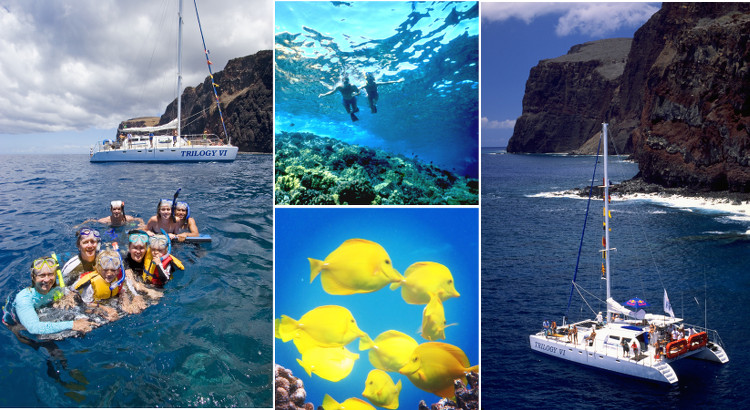The Historical Significance of Kaunolu, One of the Best Snorkeling Spots on Lanai
There aren't many places in the state of Hawai'i where you can snorkel at the home of a King.
Here at Kaunolu, however, this remote cove once housed the summer home of King Kamehameha, and in addition to the sea cliffs which explode from the shoreline like pinnacles reaching to the sky, the rocky bay and its azure waters create one of the best snorkeling spots on Lanai.
Never heard of Kaunolu?
That's ok—most visitor's haven't. Of the handful of visitors who are lucky enough to snorkel at this historic bay, the majority end up referring to the cove by its other, Westernized name:
Shark Fin Cove.
Before you go racing back to the boat, however, realize that the name is derived from the shape of a rock in the middle of the bay. Rising above a coral reef that is colonized by pyramid butterflyfish, the shape of the rock where it breaches the surface looks the dorsal of a swimming shark.
The scary name aside, however, there is far more to Kaunolu than shark-shaped rocks and pristine, tropical snorkeling. In fact, this isolated cove on Lanai's southern shoreline is one of the most culturally-rich places on Lanai, and there is no denying the powerful energy that the cove retains to this day.
King Kamehameha at Kaunolu
From 1790-1810, the great ruler, King Kamehemeha, would frequent Kaunolu as one of his favorite fishing grounds and a summer retreat from Lahaina. The waters off Kaunolu are exceptionally fertile with large, pelagic fish, and there is a small cove with a sandy shoreline for easily launching canoes.
Due its heavy historical significance, Kaunolu has been listed on the National Register of Historic Places and as a National Historic Landmark. It's believed to be the best preserved example of an ancient Hawaiian village found on any of the Hawaiian Islands, and the foundation for King Kamehameha's house still stands just opposite the heiau (temple) which was rebuilt in the early 1800s. Known as Halulu Heiau, this was one of the last temples dedicated to Hawaiian gods before the monarchy embraced Christianity. It's believed that the heiau could have been a place where rule-breakers could seek permanent refuge, and if you found your way to this pu'uhonua then you could be forgiven for any of your sins. On the other end of the spectrum, it's also rumored that Halulu heiau could have been used in human sacrifice, and fishermen who frequent the coastline today tell of an inexplicable power in the night. Because the village is so inaccessible (only a 4WD road leads down to the village), and because Lanai snorkeling tours don't visit the village site itself, this area has remained nearly completely untouched since it was abandoned in the 1880s.
Kahekili's Leap
Kamehameha, it turns out, wasn't the only member of the Hawaiian royalty who was known to frequent Kaunolu. Kahekili—the fearsome king of Maui whose body was tattooed entirely black on one side—chose this spot as a favorite venue for the sport of lele kawa, or cliff jumping.
In ancient Hawaiian culture, it was believed that upon a person's death, the soul would depart from this world to the next by leaping into the sea. Certain spots were considered sacred, and not only was Kahekili revered as a courageous warrior, but the fact that he would leap from these sacred spots only contributed to his dominance and lore.
Here at Kaunolu, there is a noticeable notch at the top of a cliff where Kahekili would leap from. Though the height of the jump is only about 70 feet, one must jump out to clear the rocks and only land in about 10 feet of water. History says that he would use this spot to test the valor and courage of his warriors, and given the degree of difficulty of the jump, the 2000 Red Bull Cliff Diving Championships were held right here at Kaunolu.
Kaunolu Abandoned
At the height of its prominence, the village of Kaunolu housed a wholly-subsistent prehistoric society. Small caves in the steep cliff face where used for storing food, and blades of pili grass were gathered from the hillside to construct a village of pili grass shacks. Canoes were launched from the small beach, water was gathered from springs in the mountainside, and fresh fish sourced from the sea were preserved with salt from the tidepools.
Between invasion, disease, and European meddling, however, the population of Lanai rapidly dwindled over the course of the 19th century. By 1901, after a failed mission on the east shore of the island to bring a sugar plantation to Maunalei, the population of the entire island dropped to 125.
With few people to maintain the village and a sparse supply of water, the village at Kaunolu was finally abandoned at some point during the 1880's. Seeing as no one moved in afterwards, however, and the isolated spot has remained free of development and free of coastal erosion, taking a walk through Kaunolu today is like taking a walk back in time. Hand etched petroglyphs from ancient Hawaiians grace the rugged brown rocks, and stone tools such as adzes and fishing tools remain littered throughout the village. For over a century, the 1,000 ft. sea cliffs of the Pali Kaholo have silently presided over this abandoned village which now remains frozen in time.
Visiting Kaunolu Today
Today Kaunolu is only frequented by three types of visitors: Local fishermen who spend the night in one of the coastal fishing shacks, intrepid tourists in 4WD vehicles who walk the remains of the village, and those who visit Kaunolu cove as part of a snorkeling tour on Lanai.
Unlike a place like Hulopo'e Beach which has a shallow, sandy bottom, the cove at Kaunolu is a little bit deeper and has multiple spots for snorkeling. Along the southern end of the cove near the base of Kahekili's Leap, the rocky bottom is an average of depth of 10-25 ft. You can find large numbers of Hawaiian day octopus slinking outside of the rocks, and healthy populations of endemic reef fish and technicolor, coral-crunching parrotfish.
In the center of the bay, next to "the fin", there is a large population of Pyramid Butterflyfish which congregate around the rock. About 25 feet down, between the fin and the shoreline, you will also find an underwater arch which free divers will use as a swim through. Finally, because it is exposed to the deeper waters, Kaunolu is known for sightings of rare species such as manta rays, dolphins, and even the occasional whale shark.
Trilogy offers private Maui catamaran charters to Kaunolu, from either Lahaina or Manele harbors. Between the fascinating history, the soaring cliffs, and the experience of having these teeming waters virtually all to yourself, it's easy to see why we consider Kaunolu to be one of the best snorkeling spots on Lanai.
Photo Credits: Shark Fin rock, Curt Smith on Flickr; Kahekili's Leap, Chris Campbell on Flickr;









